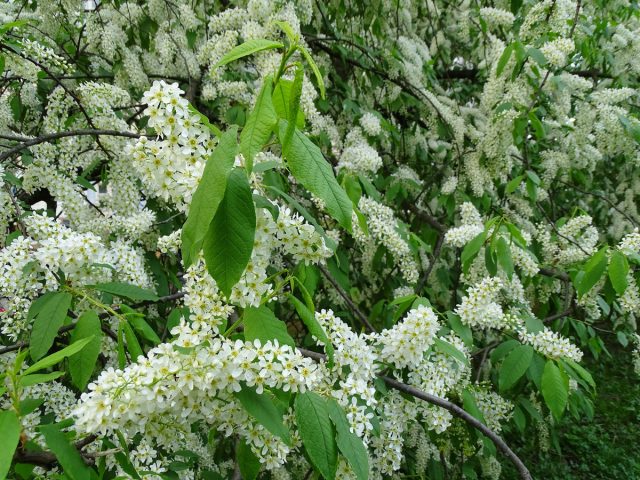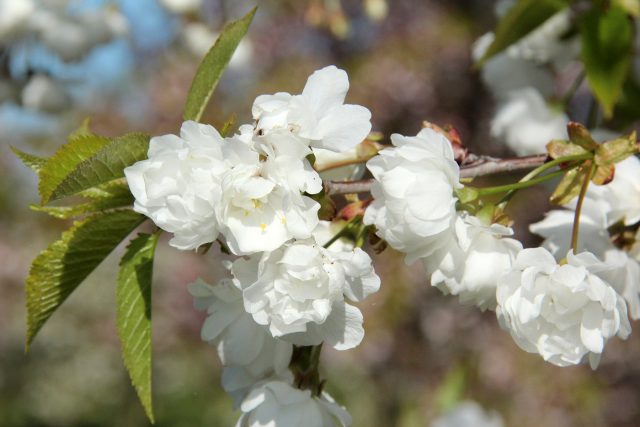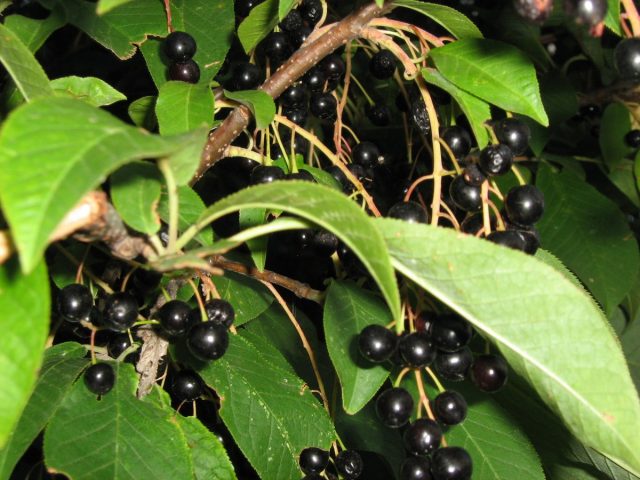Content
Bird cherry is an unpretentious tree growing in many regions of Russia. In spring, numerous small flowers with a pleasant aroma bloom on it. The following is a description of bird cherry, photos, features of cultivation and care.
Bird cherry is a berry or fruit
A fruit is an edible fruit that grows on trees and shrubs. This term is non-tanical and is more often used in everyday life. Berries are juicy edible fruits that have no partitions between the seeds and the pulp. Their main difference from fruits is their small size.
Bird cherry is classified as a berry. It has small fruits called drupes. They have a tough skin, one seed and pulp.
General description of bird cherry
Bird cherry looks like a tree or bush. Its gray or black bark is covered with white lentils. As wood ages, cracks appear. The crown is thick and wide, the branches are drooping. Young shoots are greenish or reddish, quickly acquiring a brown tint.The height of the bird cherry tree reaches 15 - 17 m.
The leaves are simple, smooth, ovate and oblong. The length of the leaf blade is from 3 to 10 cm. The edges of the leaves are jagged and pointed at the tip.
You can see what bird cherry looks like in the photo:
Bird cherry inflorescences are dense drooping tassels 10 cm long. The flowers are white or pink, very small. Each of them consists of 5 petals and a yellow core.
In July, the spherical fruits ripen. Their size is 8-10 mm. The pulp is green, astringent. The stone is ovoid. The drupes are dense and green at first. When ripe, the skin turns red, then black.
The taste of bird cherry berries is sweet and sour, highly astringent. Ripe fruits have a strengthening effect, destroy bacteria, relieve inflammation, strengthen the immune system, and normalize intestinal function.
What family does bird cherry belong to?
Bird cherry belongs to the Rosaceae or Rosehip family. This group unites pome, stone fruit and berry crops: apple, pear, raspberry, rowan, rose, etc. Bird cherry is also a representative of the Plum genus. Previously, it was classified as a subgenus of Cheremukha; according to the current classification, it is included in the subgenus Cherry.
When the bird cherry blossoms
The tree begins to bear fruit in the 5th or 6th year. Flowers appear in April-May. These deadlines vary by region. In the south, flowers appear in April, in the middle zone - in early May. In colder regions, flowering shifts to late May and early June.
The flowers have a strong aroma. With prolonged exposure, the smell causes malaise and headaches. Therefore, it is not recommended to keep cut branches in the bedroom at home.
In spring, the inflorescences produce a lot of pollen and nectar. Therefore, they are used as spring honey plants. Flowers are actively pollinated by bees and other insects. Flowering period – 14 days.
Photo of blooming bird cherry:
Where does bird cherry grow?
In nature, bird cherry is found in North America, Europe, Asia and North Africa. In Russia, the bird cherry is better known. The tree is found in the middle zone, in Siberia and the Urals. The distribution area of bird cherry includes a vast territory from the North Caucasus to the Far East.
Bird cherry prefers a temperate climate. The tree grows in fertile, moist soils. It is found in mixed and coniferous forests: on the edges, near rivers and reservoirs. It tolerates shade well, but develops faster in sunny areas. Frost resistance is high.
The culture is used to decorate gardens and park areas. Trees with a large number of leaves and inflorescences decorate summer cottages and city parks. They are used for single and group plantings.
Types of bird cherry
The bird cherry genus includes about 20 species. Among them the most famous are:
Common bird cherry. Most often found in Russia. Grows quickly, is frost-resistant, loves moist soil. The crop is planted for harvesting fruits or landscaping areas.
Bird cherry Antipka. A low tree with a spherical crown. The leaves are round, the flowers are small, white, and grow in racemes. Used for landscaping in the southern regions. Tolerant to drought, but suffers from spring frosts.
Virgin cherry. Found along rivers and ponds in North America. Reminds me of the common bird cherry.Its main difference is the smaller buds that are separated from the shoots. Tree up to 15 m high. In autumn the leaves become brightly colored. The fruits are round and change color from red to black as they ripen. The pulp is juicy and edible.
Virgin cherry berries in the photo:
Bird cherry Maak. Grows in the Far East, Korea and China. The tree reaches 17 m, has a pyramidal crown and reddish bark. The flowers are collected in long racemes. The fruits are small, round and inedible.
Bird cherry finely serrated. The plant comes from the Far East. The tree is tall, with a spreading crown, up to 25 m high. In summer the leaves are light green, in autumn they are brown and purple. Bird cherry with pink and white large flowers. The fruits are black, elongated, unsuitable for food.
The best varieties of bird cherry
The best varieties of bird cherry are considered to be those bred by domestic and Western breeders:
Colorata. A small tree and shrub up to 6 m high. Young plants have purple leaves, adults have green leaves with purple veins. The flowers are very showy, pinkish, growing in drooping racemes. Bird cherry fruits are black and suitable for consumption.
Tenderness. Produces small flowers of bright red color, collected in large racemes. Bird cherry variety Tenderness – frost-resistant shrub up to 3.5 m high. The crown is thickened, pyramidal in shape. Flowers with a pleasant delicate aroma. The fruits are sweet, medium in size. The variety Tenderness is frost-resistant and grows well in the shade.
Gull. The tree grows up to 4.5 m in height. The flowers are large and white. The inflorescences are racemose, up to 15 cm long. The flowers have a strong aroma. The leaves are elongated and green. The crown is spreading and thickened. The tree tolerates moderate frosts well.
In memory of Salomatov. Frost-resistant hybrid, brings a high yield in the early stages. About 40 kg of berries are harvested from one tree.
Captivity. Tree with a few large double flowers. The flowering period is longer than other varieties. Externally, the flowers resemble small roses. The variety is unique due to its double petals.
Bird cherry varieties for Siberia
Siberian breeders became interested in the crop for about 40 years. During the work, the best Russian forms were selected. They were crossed with Virginia and other North American species. As a result, hybrids resistant to Siberian conditions appeared.
The best varieties for Siberia:
Black glitter. Early fruiting hybrid. The tree reaches a height of 6 m. The crown is dense, pyramid-shaped. The tree is self-fertile and requires a pollinator to produce a harvest. The fruits are black, with a glossy surface, collected in dense clusters. The taste is good, sweet and sour.
The photo shows the fruits of the Black Shine bird cherry variety:
Siberian beauty. A tall tree, reaches 7 m. The leaves are green, turning purple in autumn. The fruits are black, weighing 0.7 g. The taste is good. The variety is suitable for alley decoration, as well as for single plantings.
Purple candle. Medium-sized tree with a large number of shoots. The variety got its name due to its narrow pyramidal shape, reminiscent of a candle. In spring and summer the foliage is dark green, becoming reddish in autumn. Flowering is medium, racemes up to 15 cm long.
Dawn. A Virginia variety that blooms and ripens early. The tree is not tall, no more than 3 m. Partial self-fertility, productivity increases if there is a pollinator nearby. The fruits are dark red, with tart notes.The yield is up to 10 kg of berries.
Red tent. The tree reaches a height of 4 m. The crown is dense, spherical. Inflorescences are up to 17 cm long. In autumn, the leaves acquire a purple tint, but less pronounced than that of the Siberian Beauty and the Purple Candle. The berries taste good.
Bird cherry varieties with delicious fruits
The berries are consumed fresh and widely used in cooking. They are used to prepare compotes, infusions, decoctions, and fillings for baking. Therefore, good taste of fruits is of great importance for gardeners.
Varieties with delicious berries:
Sakhalin black. An early fruiting variety, up to 7 cm high. The leaves and inflorescences are large. The flesh of the fruit is greenish. The berries have a pleasant sweet taste, with light tart notes.
Dense cyst. A universal variety of early ripening. Medium sized tree. Fruits weighing 0.6 g, slightly flattened. The skin is tender and can be easily removed from the berries. The berries have a sweet and sour tart taste, rich in sugars, acids, pectin, and vitamins.
Self-fertile. Hybrid of mid-early fruiting. The tree is large and grows quickly. Fruits weighing 0.7 g, black in color. The taste is sweet and sour, pleasant, slightly tart. The variety does not need pollinators to form ovaries.
Late joy. Mid-late fruiting hydride. Berries have a universal purpose. The tree is large and quickly grows shoots. The fruits are one-dimensional, round, with delicate skin. The pulp is yellow, sweet and sour.
Bird cherry propagation
There are two main ways to propagate bird cherry: from seed, cuttings or grafting. Each option has its own characteristics. The seedlings are placed in a sunny area with moist, fertile soil. Choose places where groundwater is shallow.The tree is also used as a rootstock for other crops.
How to grow bird cherry from a seed
The Virginia, Common and Maaka species are propagated from seeds. The best results are shown by the propagation of Virginia varieties. To get new plants, large ripe fruits are selected in the fall.
The seeds are placed in damp sand and kept in the refrigerator. It is best to plant the seeds directly into the ground. Cultivation through seedlings is allowed. In this case, the planting material is subjected to stratification for 8 months. This is a complex and lengthy process that does not always end successfully.
For planting, choose the period when the leaves have fallen. It is important to carry out the work before frost sets in. The seeds are immersed in loose fertile soil. The planting depth is 1 cm. 15 cm are left between the seeds. Then they are covered with earth and watered well. For the winter, add a layer of humus mulch.
Next year shoots will appear. During the season, the garden beds are weeded weeds and loosen the soil, preventing it from drying out. The seedlings are regularly watered with warm water. It is applied in the morning or evening strictly under the roots of the plants. In spring, bird cherry is fed with ammonium nitrate. In autumn, a mixture of potassium salt and superphosphate is added to the soil.
Shoots that are too dense are thinned out. A distance of 20-25 cm is maintained between plants. After two years, the seedlings are transferred to a permanent place.
Propagation of bird cherry by cuttings in spring
Garden bird cherry is also propagated by green cuttings. This method is suitable if the desired variety is already growing on the site. In autumn, young shoots are selected and cuttings 20 cm long are cut.In winter, they are kept in a cool place and are not allowed to dry out or become moldy.
In March, the cuttings are taken out into the light and treated with a solution of potassium permanganate. Then the planting material is placed in water and wait for the roots to appear. Planting begins when the snow melts and the soil warms up. It is best to choose a lighted area for planting.
The seedlings are transferred to fertile soil. Leave 20 - 30 cm between plants. The cuttings are placed in holes and their roots are covered with soil. Be sure to water the plants abundantly. It is not recommended to replant them frequently, so a permanent place is immediately found for the seedlings.
The cuttings are constantly looked after. The soil is moistened as it dries. Warm, settled water is poured under the root of the plant. It is best to choose morning or evening periods for watering. After rain or moisture, the soil is carefully loosened so as not to damage the roots.
Bird cherry grafting
Bird cherry is also propagated by grafting. Many varietal characteristics are lost when propagated by seeds. A winter-hardy ordinary species is chosen as a rootstock. This allows you to get a hybrid with unusual flowers or tasty fruits. As a result, 95% of scions take root.
Methods for grafting bird cherry:
- Budding. The deadline for the work is the end of July. First, prepare the main tree: the branches are removed from the lower part and 5 strong shoots are left. Annual cuttings with strong wood are chosen as rootstocks. A T-shaped hole is cut in the bark. The graft is placed in it and tied around it.
- Copulation. This method is used for small trees when it is impossible to make a hole in the bark. Work begins in winter or early spring, before sap flow begins.Identical cuts are made on the rootstock and cuttings, which are combined and wrapped.
Grafted seedlings need special care. They are watered and fed with nitrogen fertilizers: a solution of mullein, ammonium nitrate, nitrophoska.
What can be grafted onto common bird cherry?
Bird cherry is a winter-hardy and unpretentious tree. Therefore, it is used as a rootstock for other crops. This method of propagation is chosen in cold regions where it is difficult to grow fruit trees from seedlings.
Grafting plums and pears is less successful. The leaves on the scion begin to turn yellow and fall off. Plum requires a lot of nutrients that bird cherry cannot provide. Pear rarely gets along with any scions.
Conclusion
The unpretentious bird cherry, the photo of which was given above, pleases summer residents with its flowering and abundant fruiting. Both wild and cultivated varieties are suitable for planting. Bird cherry can be grown from seeds or cuttings. The tree is also used as a rootstock.































